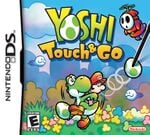Template:Featured: Difference between revisions
(Updated to Super Mario Kart) |
(Updated) |
||
| Line 1: | Line 1: | ||
<noinclude>'''Please read:''' If you are going to replace the current information on the Featured template, please see [[Template:UpcomingFA|here]] before doing that and look at which order our next FAs will be put on this page. [[Category:Main page templates]]</noinclude>{{featured-image| | <noinclude>'''Please read:''' If you are going to replace the current information on the Featured template, please see [[Template:UpcomingFA|here]] before doing that and look at which order our next FAs will be put on this page. [[Category:Main page templates]]</noinclude>{{featured-image|YoshiTouchGo.jpg|150px}} | ||
'''''[[ | '''''[[Yoshi Touch & Go]]''''' is a [[Nintendo DS]] [[Genre#Platform|platform]]/[[Genre#Puzzle|puzzle]] game developed by [[Nintendo Entertainment Analysis and Development|Nintendo EAD]] and first released in Japan and the ROC on January 27, 2005. It is the only spin-off game in the [[Yoshi's Island (series)|''Yoshi's Island'' series]]. Here, the player guides an auto-running [[Yoshi]] and [[Baby Mario]] through an array of side-scrolling courses. The game is almost entirely touch driven, using the DS's stylus to fire [[Yoshi Egg|eggs]] at enemies, trap them in [[bubble]]s, and build bridges or ramps for Yoshi to walk on. The "Touch & Go" in this game's title is a phrase more or less synonymous with "risky", which reflects the overall gameplay where the player needs to multi-task against multitudes of obstacles to succeed. The game first started out as a tech demo for the Nintendo DS under the title ''[[Balloon Trip]]'', where it was decided to adapt the game as a full title due to its positive reception. | ||
Latest revision as of 03:22, February 15, 2025
Please read: If you are going to replace the current information on the Featured template, please see here before doing that and look at which order our next FAs will be put on this page.
Yoshi Touch & Go is a Nintendo DS platform/puzzle game developed by Nintendo EAD and first released in Japan and the ROC on January 27, 2005. It is the only spin-off game in the Yoshi's Island series. Here, the player guides an auto-running Yoshi and Baby Mario through an array of side-scrolling courses. The game is almost entirely touch driven, using the DS's stylus to fire eggs at enemies, trap them in bubbles, and build bridges or ramps for Yoshi to walk on. The "Touch & Go" in this game's title is a phrase more or less synonymous with "risky", which reflects the overall gameplay where the player needs to multi-task against multitudes of obstacles to succeed. The game first started out as a tech demo for the Nintendo DS under the title Balloon Trip, where it was decided to adapt the game as a full title due to its positive reception.
